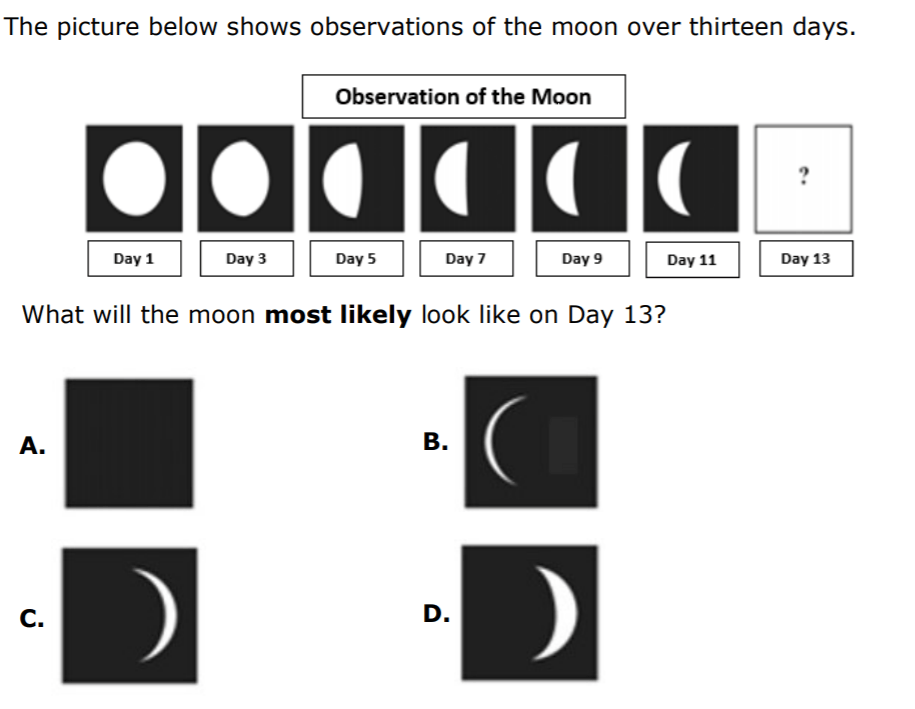
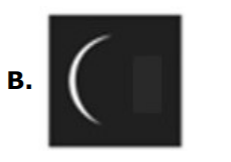
How are rocks classified?
a. its color in sunlight
b. its mass and volume
c. how it is formed
d. the number of minerals it has in it
c. how it is formed
Which of the following is a nonrenewable resource?
a. wind energy
b. solar energy
c. limestone
d. water energy
c. limestone
Which statement doesn't describe the effect of weathering?
a. ocean waves washing sand off of the beach
b. wind blowing sand and pebbles off a sand dune
c. rocks are moved from one place to another
d. tree roots breaking rocks into smaller pieces of rock
c. rocks are moved from one place to another
There are three containers, each has a sugar cube. The first container was shook for 10 seconds, the second container was shook for 20 seconds, and the third container was shook for 30 seconds. What is the flaw in the procedure?
a. the cubes were different sizes
b. the wasn't enough water in the containers
c. the containers were different sizes
d. the container was shaken for different amounts of time
d. the container was shaken for different amounts of time
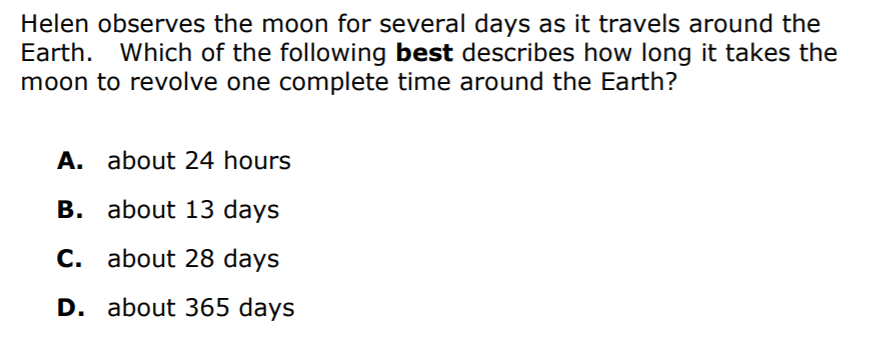
C. About 28 days
Which type of rock is most likely formed around the bottom of a volcano?
a. mineral
b. igneous
c. sedimentary
d. metamorphic
b. igneous
Which of the following is not a renewable resource in Florida?
a. citrus
b. water
c. phosphate
d. cattle
Which of the following will NOT have an effect on the weathering of a land form?
a. the wind of a hurricane striking the land form
b. the roots of plants growing in the land form
c. water freezing in the cracks of the land form
d. gravity pulling down on the land form
d. gravity pulling down on the land form
Joe has just conducted an experiment to show how sedimentary rocks weather. Other students want to conduct his experiment. What does Joe need to share with the students?
a. his conclusion
b. the data he collected
c. the procedure he designed
d. his hypothesis
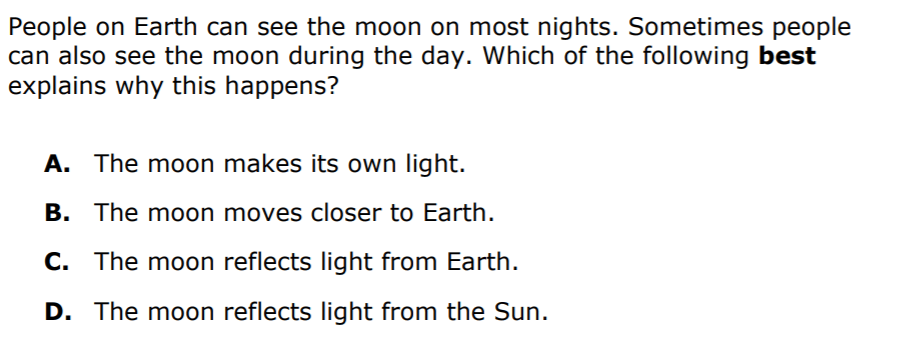
D. The moon reflects light from the sun
Grant finds a rock that was formed when tiny particles of other rocks were cemented together. What type of rock did Grant find?
a. metamorphic
b. mineral
c. igneous
d. sedimentary
d. sedimentary
What makes oil a nonrenewable resource?
a. It causes some pollution.
b. It takes hundreds of years for oil to be formed.
c. It is constantly recycled so it can be used again.
d. It is necessary for all plants and animals to have for survival.
b. it takes hundreds of years for oil to be formed
Which of the following actions represents the weathering of these rocks?
a. the bumping and scraping of the rocks
b. the movement of the rocks along the river
c. the settling of the rocks at the bottom of the river
d. the covering of the rocks with sediments that pile up
a. the bumping and scraping of the rocks
Addison visits the beach on a hot, sunny day. The ocean waves get closer as she walks along the shore. The sand castle she built isn't there anymore. Which of the following is an inference she could make during her visit to the beach?
a. the weather at the beach is hot and sunny
b. the waves washed her sand castle away
c. the sand stuck to her feet as she walked along the shore
d. the ocean waves are moving
b. the waves washed her sand castle away

B. Earth's rotation on its axis
If a mineral breaks and it is rough and jagged, what property is being represented?
a. streak
b. cleavage
c. luster
d. hardness
b. cleavage
What would happen if a nonrenewable resource was all used up?
a. products couldn't be made
b. the resource would no longer need to be produced
c. the resource would be made in a factory
d. you can't use up a nonrenewable resource
a. products couldn't be made
Which of Samantha’s observations is NOT an example of erosion?
a. wind blowing sand
b. rain falling onto the beach
c. sand castles becoming smaller
d. ocean waves moving sand back and forth
b. rain falling onto the beach
Steve wants to remember some of the details of the beetle he found in the woods so he draws a picture in his science notebook. Which of the following best explains what Steve is doing in his science notebook?
a. following a procedure
b. making a hypothesis
c. forming a conclusion
d. constructing models
d. constructing models
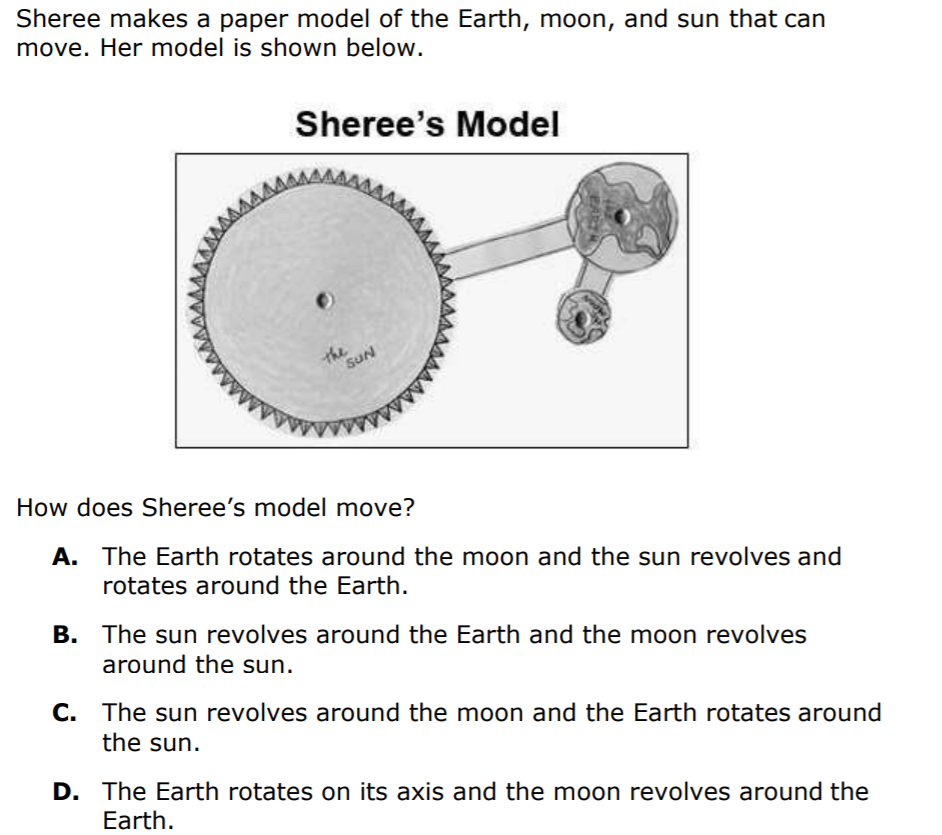
D. The Earth rotates on its axis and the moon revolves around the Earth
What is being tested if a minerals surface reflects light?
a. streak
b. luster
c. cleavage
d. hardness
b. luster
Florida’s nickname is the Sunshine State. Sunshine is one of Florida’s most abundant resources. What type of resource is sunshine?
a. scarce
b. renewable
c. nonrenewable
d. one of the fossil fuels
b. renewable
Erik is investigating how rocks can change over time. He carries out the following procedure:
- Observe several sugar cubes.
- Place the sugar cubes in a jar.
- Seal the jar and shake it 50 times.
- Dump the sugar cubes out onto a piece of black paper.
- Compare the appearance of the sugar cubes to their original size and shape.
What process is Erik studying?
a. deposition
b. erosion
c. segmentation
d. weathering
d. weathering
The class has just completed an investigation. What should we do next?
a. share our results
b. keep the data a secret
c. copy the data from another class
d. do another investigation
a. share our results